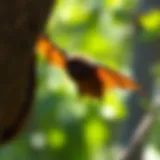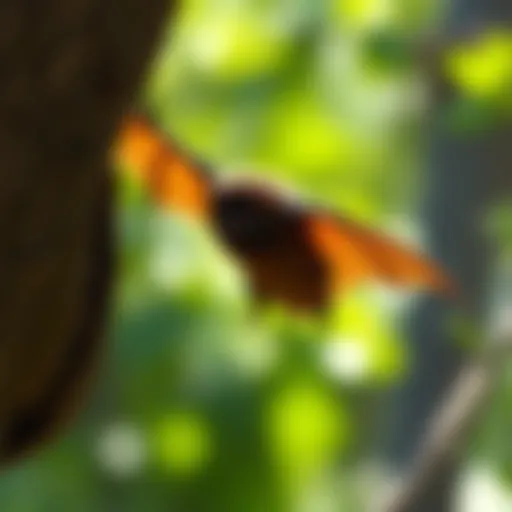Identify Squirrel Entry Points in Your Home
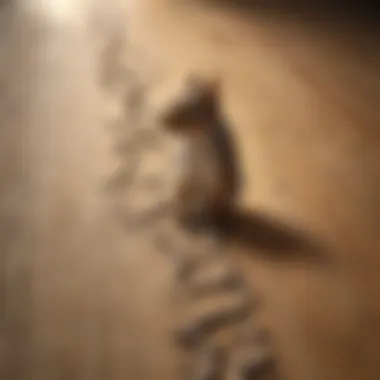

Intro
Squirrels are common urban wildlife, but they can cause significant damage when they gain access to residential spaces. To effectively manage this pest, it is crucial to identify how they enter homes. Understanding their behavior and preferred entry points allows homeowners to take proactive steps in preventing infestations.
Understanding Pests
Definition of Pests
Pests are organisms that cause harm or discomfort to humans, properties, or agriculture. In urban settings, squirrels fall into this category as they can damage roofs, attics, and gardens. The ability of these creatures to adapt to urban environments makes them particularly challenging to manage.
Importance of Pest Identification
Knowing the specific pests in your area enables better management and control. Squirrel identification is essential to tailor effective solutions. By recognizing their behavior and typical entry points, homeowners can respond appropriately and reduce the risk of damage.
Inspection Techniques
Considering the critical role of inspections in identifying entry points, homeowners should proactively assess their properties for signs of squirrel activity. Here are some strategies for effective inspections:
- Look for Visible Signs: Scratches on walls or gnawing on wooden surfaces may indicate a squirrel problem.
- Inspect Loft Spaces: Squirrels often enter attics; check for droppings or nesting materials.
- Examine Exterior Spaces: Look for gaps around trees, roofs, and eaves.
Common Access Points
Squirrels can access homes through various means. Being aware of these common entry points can assist in preventing infestations:
- Roofs and Gutters: Squirrels may climb trees and jump onto roofs, finding gaps along the edges or in vents.
- Chimneys: Openings in chimney systems can let squirrels enter attics.
- Windows and Doors: Damaged weather stripping can create opportunities for entry.
Prevention Techniques
Home and Garden Preventative Measures
Preventing squirrel entry involves ensuring your home is secure. Here are actions to consider:
- Seal Gaps: Use caulk or foam to fill cracks and holes in walls and foundations.
- Install Mesh Screening: Using metal mesh can effectively block entry points.
- Trim Trees: Keeping branches trimmed away from your home minimizes access.
Seasonal Prevention Tips
Different seasons present various challenges. Tailor your approach as follows:
- Spring and Summer: Regularly check for nests and clear debris from yards.
- Fall: Inspect for new access points as squirrels prepare for winter.
Eco-Friendly Pest Control Solutions
Overview of Sustainable Practices
Implementing sustainable practices is important for effective pest management. This can include the use of traps that do not harm animals while effectively keeping them away from your property.
Natural Remedies and Their Effectiveness
Some natural remedies may deter squirrels effectively without using harmful pesticides. Consider:
- Cayenne Pepper: Sprinkling this can make areas less appealing.
- Essential Oils: Oils like peppermint may repel squirrels by masking scents.
Important: Always check local regulations regarding wildlife control before taking action, as some methods may not comply with local laws.
These strategies will allow homeowners to enhance their pest control efforts, ensuring a reduction in squirrel infestations while promoting responsible wildlife management.
Understanding Squirrel Behavior
Understanding squirrel behavior is essential for homeowners seeking to prevent infestations. Squirrels have particular habits and traits that guide their movements and decisions. Knowing these patterns helps elucidate why they might be drawn to a home and how they manage to enter.
One important aspect of squirrel behavior is their adaptability. Squirrels can thrive in diverse environments, including densely populated urban areas. This adaptability increases the likelihood of their presence in residential spaces. Additionally, squirrels are resourceful in finding food and shelter. They often seek out habitats that offer safety and easy access to food sources. Understanding these elements allows homeowners to anticipate where squirrels might attempt to enter their homes.
Moreover, recognizing squirrel behavior gives insight into the challenges of managing these pests. Squirrels typically create nests in areas that provide protection from predators and harsh weather. Knowledge of these tendencies is beneficial in identifying potential entry points. By understanding the motivations behind their behavior, better preventive measures can be implemented.
Common Traits of Squirrels
Squirrels share common traits that are integral to their survival. Generally, they are social creatures, often seen foraging in groups. Their keen agility and sharp senses make them excellent climbers and foragers. Squirrels possess strong teeth that continually grow, leading them to gnaw on various materials to keep their teeth trimmed. This gnawing behavior poses a significant concern for homeowners, as they may damage homes or gardens.
Another common trait is their high activity levels during dawn and dusk. During these periods, they are most active, making it critical to inspect homes at these times for evidence of entry. Their instinct to store food is also noteworthy; they bury nuts or cache food in various locations, which may lead them closer to residential areas in search of secure places.
Squirrels and Urban Environments
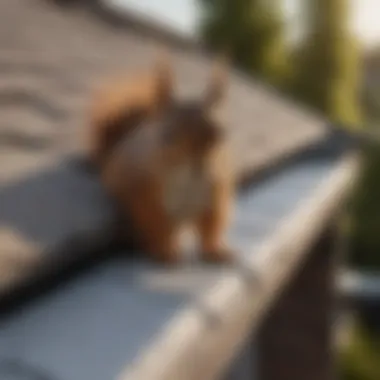

In urban settings, squirrels thrive amidst human habitation. The abundance of trees, buildings, and food sources provides a perfect environment. Parks, gardens, and backyards typically offer plenty of foraging opportunities. Urban areas often lack natural predators, making it easier for squirrels to establish themselves without fear.
Squirrels have adapted their diet as well, frequently consuming discarded food and seeds from gardens. This adaptability not only ensures their survival but also makes them a common sight in residential areas. With fewer natural barriers in cities, squirrels are emboldened to explore human infrastructures for potential nesting sites and food sources.
Why Squirrels Enter Homes
Squirrels may enter homes for several reasons. Primarily, they seek shelter, especially during winter months when natural nesting sites become scarce. A warm attic or basement can provide a safe haven. Additionally, food availability is a significant motivator. Squirrels might access pantries or left-open containers in search of sustenance. A common situation involves unsecured compost bins or bird feeders that invite squirrels closer to the house.
Understanding these reasons is crucial for developing effective prevention strategies. Homeowners should be vigilant about covering food sources and sealing entry points. Recognizing that squirrels are driven by specific behaviors enhances one's ability to protect the home from potential infestations.
Identifying Potential Entry Points
Identifying potential entry points is essential for homeowners looking to minimize the risk of squirrel infestations. Understanding where squirrels are likely to enter can save time and resources in pest management. Squirrels are agile creatures able to exploit various weaknesses in a home’s exterior. By locating these points of entry, you can take proactive steps to protect your home and prevent unwanted guests.
Roof Access
Common Roof Materials
Roof materials play a crucial role in the overall integrity and safety of a home. Common roofing types include asphalt shingles, metal sheets, and tile. Each has distinct characteristics. For example, asphalt shingles provide ease of installation and maintenance, while metal roofing is known for durability and lifespan. However, the choice of material can affect squirrel entry.
Squirrels may exploit loose or damaged shingles, making it vital to inspect the roof regularly. Timely maintenance of roofing materials can help reduce potential access points.
Identifying Weak Points
Identifying weak points in your roof structure is a fundamental aspect of protecting your home. Weak points can be due to improper installation, age, or weather damage. Pay attention to areas where materials might overlap or curl. These spots often present vulnerabilities. By reinforcing or repairing these weak spots, you create a less favorable environment for squirrels.
Attic Ventilation
Types of Vents
Your attic’s ventilation system plays a significant role in keeping your home comfortable but can also become an entry point for squirrels. Common types of attic vents include gable vents, ridge vents, and soffit vents. Each type has benefits, such as energy efficiency and airflow improvement. However, these can become problematic if compromised. Ensure that mesh screens are intact to keep squirrels at bay.
Signs of Infestation
Recognizing signs of squirrel infestation in your attic is key for early detection. Look for droppings, gnaw marks, or nesting materials. Squirrels tend to create nests from insulation, leaves, or other materials. It is essential to act quickly as infested attics may lead to property damage or health risks due to droppings.
Utility Lines
Power Lines
Power lines are commonly overlooked when considering entry points for squirrels. Squirrels are adept at climbing and can use these lines to access your roof or eaves. Their agility allows them to traverse wires easily. This makes it necessary to inspect nearby power lines and their attachments to the home for potential access risks.
Telecommunication Equipment
Squirrels may also utilize telecommunication equipment like satellite dishes and cables as pathways to enter homes. Inspect connections closely, and consider using protective materials to close any gaps. Failure to address this can lead to significant structural damage.
Gaps and Cracks in the Structure
Common Locations
Gaps and cracks often develop due to shifts in the building’s foundation or normal wear and tear. Common locations include windows, doors, and foundation seams. These openings can be very inviting to squirrels looking for shelter. It's beneficial to routinely check these areas and seal any gaps properly.
Measuring Openings
Measuring openings to determine their sizes can be an effective way to assess vulnerabilities. Openings larger than a quarter-inch are generally accessible to squirrels. By accurately measuring and documenting these gaps, homeowners can prioritize sealing efforts effectively and ensure fewer entry points remain.
Basement and Crawl Spaces
Access through Ducts
Ducts can provide squirrels with hidden routes into your home. They may access these areas through exterior vents or broken ductwork. Regular inspection and maintenance of these spaces can minimize risks. Ensure that all ducts are sealed correctly and free from debris.
Signs of Entry
Signs of entry in basements or crawl spaces include scratching sounds, droppings, or nests. Check corners and hidden areas frequently. If you suspect entry, prompt action is necessary to assess the situation and prevent further access.
Remember: Preventing squirrel entry is not just about seeing them; it’s about understanding their behavior and potential entry points.
Conducting a Thorough Inspection
Conducting a thorough inspection is crucial for identifying where squirrels are entering your home. A methodical investigation allows homeowners to find the entry points before they become significant issues. By understanding the habits of squirrels and examining your property with care, you can effectively prevent potential infestations. This section will focus on practical steps for inspection, tools needed, visual techniques, and how to recognize the signs of squirrel activity.
Preparing for Inspection
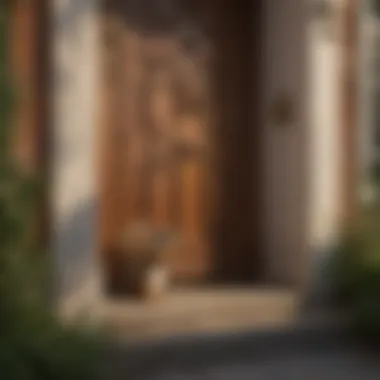

Necessary Tools
When it comes to inspecting your property for squirrel entry points, having the right tools is essential. A flashlight is a basic yet indispensable tool, useful for illuminating dark areas like attics and basements. Binoculars are handy for assessing high points like rooftops from the ground. A ladder may also be necessary for closer inspection of elevated structures. The key characteristic of these tools is their accessibility. Most homeowners can easily acquire them without incurring significant expense.
A unique feature of using a flashlight is its ability to reveal hidden spaces where squirrels may hide or enter. It allows for a visual assessment of areas that are otherwise difficult to see. However, relying solely on basic tools might limit your effectiveness. In some cases, you may need to invest in more specialized equipment for a comprehensive inspection.
Safety Precautions
Safety precautions cannot be overlooked during your inspection. Protecting yourself should be a priority. Wearing gloves is essential, as it reduces the risk of exposure to diseases that squirrels can carry. A hardhat may also be necessary if you are inspecting your roof, as falling debris can pose a danger. Another critical safety measure is to ensure that you are aware of your surroundings while using a ladder.
The primary characteristic of these precautions is their effectiveness in preventing injuries. It may seem tedious, but prioritizing safety makes the inspection process smoother and more efficient. A unique aspect of emphasizing safety sheers is reducing anxiety as you examine precarious areas. With proper precautions, you can avoid accidents that could arise during your inspection, ensuring a successful assessment.
Visual Inspection Techniques
External Examination
External examination involves evaluating the exterior of your property to find potential entry points for squirrels. This includes examining walls, roofs, and gutters for any gaps or holes. The benefit of a thorough external examination is that it allows for a proactive approach to pest prevention. By identifying access points before squirrels can infiltrate, you mitigate your risks.
A unique feature of this technique is its straightforward process. Start at ground level and work your way up, looking for signs of wear or damage. However, be cautious about your footing on uneven surfaces. This method of inspection is popular as it allows you to deal with potential problems before they escalate.
Internal Examination
Internal examination complements the external check. This step involves inspecting areas inside your home where squirrels might take refuge. Attics, basements, and crawl spaces are key areas to focus on. The importance of this technique lies in identifying the presence of squirrels after they have gained entry. This insight enables targeted control measures.
The characteristic of internal examination is its focused nature. Once inside, look for trails, nests, or scratching noises that might indicate a squirrel presence. It can often reveal more than an external check alone. However, navigating complex internal spaces can be challenging, and it's crucial to proceed with caution.
Identifying Squirrel Signs
Tracks and Droppings
Recognizing tracks and droppings is vital for confirming a squirrel presence in your home. Tracks often appear as small, distinct footprints leading to or from possible entry points. The droppings, typically dark pellets, can also reveal the extent of an infestation. Understanding these signs contributes to the overall goal of pest management, allowing homeowners to take proactive measures.
The key feature of tracks and droppings is their specificity. They provide concrete evidence of squirrels' activities, which aids in evaluating the severity of the problem. However, relying solely on these indicators may lead to misinterpretation without considering additional investigative steps.
Chewing Patterns
Squirrels are notorious for their chewing habits. They may gnaw on wood, wires, or insulation within walls and attics. Recognizing chewing patterns can help you identify areas of concern and potential entry points. This understanding is crucial for determining the necessary preventive measures.
The characteristic of recognizing chewing patterns is their visibility. Chewed items often leave distinctive marks, intensifying your investigation. However, these signs may be confused with other pests, so it's essential to assess them in context with the whole inspection process.
Utilizing Technology
Infrared Cameras
Infrared cameras are an innovative tool for locating squirrel entry points in hard-to-reach spaces. These devices can detect body heat, making them effective for identifying squirrels hidden within walls or attics. Utilizing technology enhances your inspection strategy, overall improving the chances of detection.
A significant feature of infrared cameras is their non-invasive nature. Homeowners can monitor for squirrel activity without causing disturbances. However, investing in this technology could be costly for some. Consider the size of your property and the severity of previous issues when deciding if this tool is worth purchasing.
Motion Sensors
Motion sensors are another useful tool for detecting squirrel activity. These devices trigger alerts when they sense movement, providing real-time notifications of potential intrusions. The significant advantage here is the immediate knowledge of any squirrel presence, enabling quick action.
The key characteristic of motion sensors is their simplicity and effectiveness. Many options are available in the market, catering to various budgets. However, false alarms are a potential drawback, which may cause unnecessary anxiety for homeowners. Monitoring the reliability of the device remains a priority when implementing this technology.
Preventive Measures to Block Entry
Understanding how to effectively block squirrel entry points is crucial for homeowners. Preventive measures ensure that squirrels do not return after an initial removal effort. They also help in maintaining the structural integrity of the home. By addressing vulnerabilities, homeowners can create a less welcoming environment for these animals. Additionally, long-term prevention is often more cost-effective than ongoing infestations.
Sealing Gaps and Cracks
Sealing gaps and cracks is a fundamental step in preventing squirrel entry. Squirrels can exploit even tiny openings. To close these vulnerabilities, homeowners should inspect the entire exterior of their home. Using durable materials such as foam insulation, caulk, or steel mesh is recommended.
Benefits of sealing include:
- Cost-effectiveness: This method requires minimal investment and can yield significant results.
- Reduced energy costs: Proper sealing can improve insulation, lowering heating and cooling expenses.
- Enhanced aesthetic appeal: Closing up gaps can improve the overall look of the property.
Installing Squirrel-Proof Devices
Grates and Screens
Grates and screens serve as effective barriers against squirrel entry. These devices are particularly useful for blocking off vents and chimneys. The key characteristic of grates is their sturdy construction. They can withstand the gnawing of rodents, thus protecting vulnerable entry points. Screens can also be installed over vents to prevent access while allowing airflow.


Advantages include:
- Durability: Quality materials last longer and resist damage.
- Visibility: Screens can often be installed subtly, maintaining the appearance of the home.
- Low maintenance: Once installed, grates and screens require little upkeep.
One-Way Doors
One-way doors are an interesting solution designed to allow squirrels to exit but prevent re-entry. These devices can be strategic in areas where squirrels are known to inhabit. The main benefit is that they can remove a squirrel population humanely without the use of traps or poisons.
Considerations include:
- Effective relocation: One-way doors can guide squirrels away from residential areas.
- Risk of blockage: If not monitored, they can potentially block animals if malfunctioning.
- Installation: Proper installation is crucial for effectiveness and may require professional assistance.
Maintaining Property
Regular maintenance of the property forms a key component of preventing squirrel access. Homeowners can discourage squirrels by keeping their exterior tidy and well-managed.
Landscaping Practices
Effective landscaping practices can deter squirrels effectively. Keeping branches trimmed away from roofs and removing seed sources makes properties less attractive.
Key aspects of landscaping include:
- Tree Trimming: Maintain trees so they do not touch the house, creating access points.
- Plant Selection: Opt for non-fruiting plants to reduce enticing food sources near the building.
Debris Management
Debris management involves clearing away items like wood piles, leaves, or trash that can provide nesting materials.
Benefits of managing debris:
- Clear space: Fewer hiding spots help to discourage squirrels from lingering.
- Aesthetic value: A well-maintained yard proves visually appealing and discourages pests.
Maintaining a clean property is an essential step toward squirrel prevention. Regular vigilance in managing access points can lead to successful pest management.
When to Seek Professional Help
Understanding when to engage with professionals is essential for effective squirrel control. While homeowners can often handle small issues, there are moments when an expert's assistance becomes necessary. Recognizing these moments can save time and money in the long run, ensuring that the problem is resolved quickly and humanely.
Signs of a Severe Infestation
Knowing how to detect a severe infestation is crucial for making an informed decision on if professional help is needed. Look out for the following signs:
- Frequent Noises: If you hear scratching, scurrying, or chatter that is constant, this indicates that squirrels may be nesting or frequenting your home.
- Visible Damage: Check for signs of gnawing on wires, insulation, or wooden structures. This can lead to more serious structural issues.
- Droppings: Finding squirrel droppings, especially in concentrated areas, may point toward a significant issue.
- Nest Presence: If you discover nests in hidden areas like attics or basements, it's likely that squirrels have established a home.
These indicators suggest more than a simple problem. They hint at a potential rapid increase in squirrel populations within your home. Immediate action is often required to prevent further damage and health risks.
Choosing the Right Professional Service
Once the need for professional help arises, selecting the right service becomes crucial. Here are some factors to consider:
- Experience and Expertise: Look for companies that specialize in wildlife control or pest management, specifically those that have proficient knowledge of local squirrel behavior.
- Humane Methods: Ensure that the service uses humane techniques for trapping and removal, adhering to local wildlife laws.
- Reputation: Research reviews and testimonials to gauge the reliability and efficiency of the company.
- Warranties and Follow-Up Services: Some companies offer warranties that cover future issues or follow-up inspections to ensure the problem does not return.
It's wise to ask questions during initial communications. Discuss methods, costs, and timelines to gain clarity on the service.
Squirrels may seem harmless but can cause damage and health concerns. Be proactive in evaluating your options for professional help.
Understanding Local Wildlife Laws
Understanding local wildlife laws is essential for homeowners who are dealing with squirrel infestations. Ignorance of these laws can lead to legal issues, especially when it comes to either capturing or removing these animals from your property. Many regions have specific regulations that offer protection to squirrels and other wildlife. This legal framework is aimed at ensuring ecological balance, promoting humane treatment, and safeguarding animal rights.
Familiarity with local wildlife laws encourages more responsible management practices. For example, certain traps or poisons may be illegal in your area. If homeowners unknowingly use such methods, they could face fines or other penalties. Therefore, it is vital to review and understand the laws before taking any action.
Legal Considerations
Legal considerations surrounding wildlife management vary significantly by location. Homeowners should start by researching the regulations applicable in their state or municipality. Some jurisdictions may require permits for wildlife capture or relocation. Additionally, fines may exist for mishandling or harming wild animals.
- Research regulations: Check your state's wildlife agency website for guidelines.
- Know your responsibilities: In some areas, residents are responsible for wildlife that enters their property.
- Consider endangered species: Ensure that the species of squirrels in your area are not protected under local law.
Failure to comply with these legal requirements can result not only in fines but also damage your reputation in your community. Understanding these laws supports ethical treatment of wildlife and compliance with your local governance.
Humane Treatment of Wildlife
Humane treatment of wildlife is a crucial aspect of addressing squirrel infestations. It entails respecting their rights as living creatures while managing the challenges they pose. Solutions should focus on preventing harm and ensuring that any removal methods are ethical.
- Employ non-lethal traps: If you must trap, use humane traps that allow for safe release.
- Seek humane relocation services: Professional services can relocate squirrels to natural habitats far from residential areas.
- Educate yourself: Learning about squirrel behavior can facilitate better interactions without harming them.
"Respect for animal welfare should be a guiding principle when managing wildlife issues at home."
Adopting humane practices not only complies with the law but also fosters a sustainable relationship with local wildlife. It creates a proactive approach to discourage squirrels from entering the home without unnecessary suffering.


